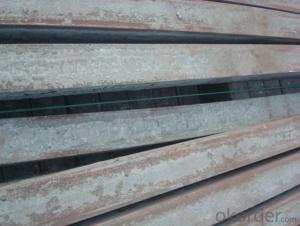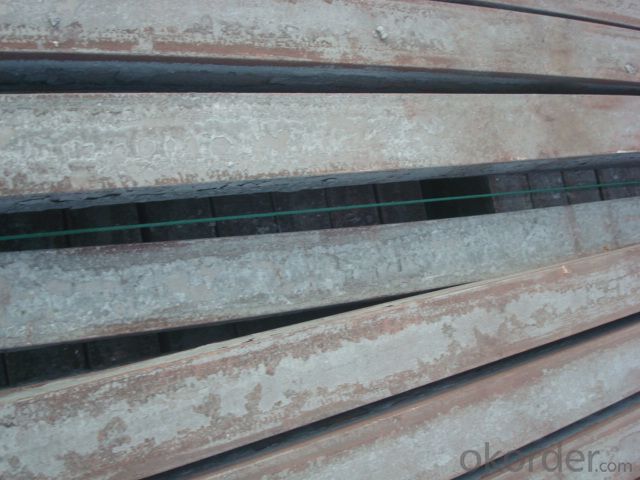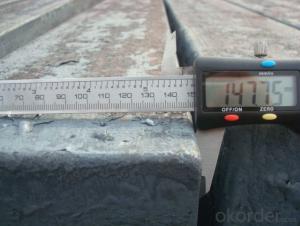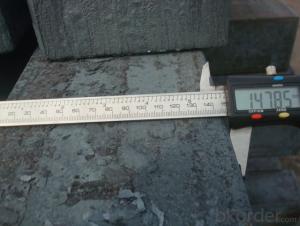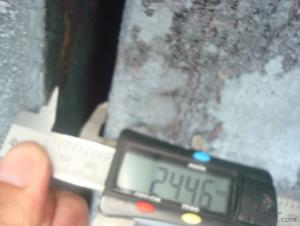Steel Billets or Blooms Manufactured by Continue Casting
- Loading Port:
- Tianjin
- Payment Terms:
- TT OR LC
- Min Order Qty:
- 1000 m.t.
- Supply Capability:
- 10000 m.t./month
OKorder Service Pledge
OKorder Financial Service
You Might Also Like
Steel Billets or Blooms Manufactured by Continue Casting
1.Structure of Steel Billets or Blooms Manufactured by Continue Casting
Steel Billets or Blooms Manufactured by Continue Casting is the raw material of all kinds of steel mill. Billet section of square, round, flat, rectangular and abnormity, etc Several, mainly related to shape of rolled products. Simple rolled section steel, choose cross section of square billet or rectangular billet. rolling The sector products such as flat steel, Angle steel, select the rectangular billet or slab. Had better profiled billet when production beams, channels, and in rolling process Lines and improve the yield. The raw material of round billet is the production of seamless tube.
2.Main Features of Steel Billets or Blooms Manufactured by Continue Casting
Steel Billets Manufactured by Continue Casting section size should meet the requirements of rolling deformation and finished product quality, but also roll strength and biting condition of restrictions. General steel Billet section height H. And the roll diameter D The ratio of the ( namely H/D) Should be less than or equal to zero 0.5 . Length of steel billet by finishing temperature, Rolling time and the length of the product Or times ruler. When heated too long accident prone to bump the furnace wall of steel, too short, furnace bottom utilization rate is not high, influence the heating furnace production. For the production Choose a variety of steel and steel billet, should consider the affinities of billet, as far as possible in order to improve the productivity of the roughing mill, simplify the stock management of workshop.
There are three shapes of the steel billets: square billet, slab, rectangular billet The Chinese billet, rectangular billet is mainly suitable for rolling hot rolled strip, building reinforced bar, Ordinary wire, high speed wire rod and various small profile. Of the slab are mainly used for rolling plate and hot coil sheet.
3. Steel Billets or Blooms Manufactured by Continue Casting Images
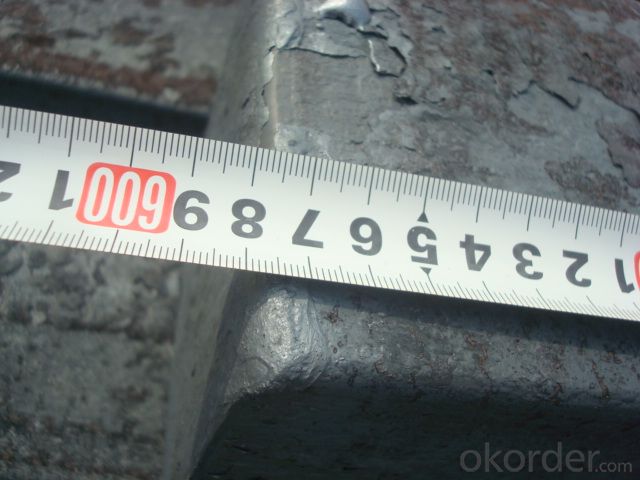
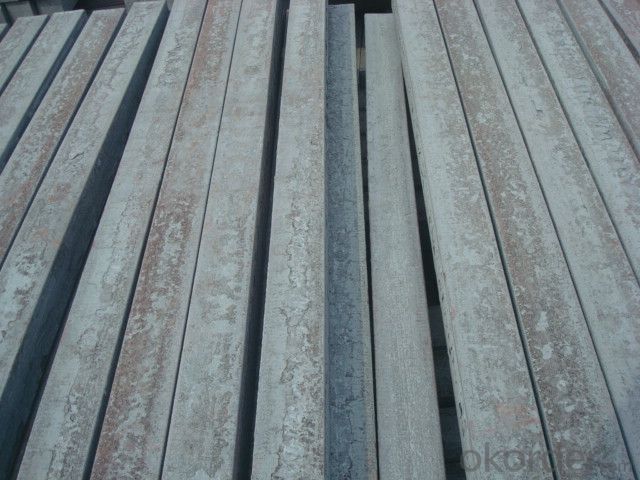
4. Steel Billets or Blooms Manufactured by Continue Casting Specification
Steel Billets Manufactured by Continue Casting rolled steel, after processing can be used for mechanical parts, forging parts, processing all kinds of steel, steel Q345B channel steel, wire rod is the role of the billet. Steel billet is used in the production of semi-finished products, generally cannot be used directly for the society. Steel billets and steel are strictly divided into standard, cannot decide to whether the business enterprise of the final product, and according to unified standards to perform the whole society. Typically, billet and the steel is relatively easy to distinguish, but for some steel billet, and have the same specification and same steel purposes (such as rolling tube billet), whether can be used for other industries, whether through steel processing process, whether through a finished product rolling mill processing to distinguish
Material standard The editor Range of thickness: 150-240 - mm + / - 5 mm width range: 880-1530 - mm + / - 20 mm Length: 3700-10000 - mm + / - 500 - mm Cross-sectional size: 64 * 64; 82 * 82; 98 * 98; 124 * 124; 120 * 150; 152 * 164; 152 * 170 mm Length: 9000 mm Section of tolerance: billet: 1.0 + / - 2.0-1.0 + / - 1.0 mm slab: width: + / - 2.0 mm thickness: + / - 3.0 mm The length tolerance: + / - 200 mm Section diagonal tolerance: 3.5-8.0 MM Billet section size protrusions requirements: < 1242 mm, do not allow; > = 1242 mm, < = 2 mm 1242 mm, < = 3 mm Beheading (shear) extension deformation: < 1242 mm billet: no control; The slab: < = 15 mm Surface tilt: no more than billet section 0.1 Bending: every 1 m length is not more than 10 mm The distortion: length < = 5 m, < = 11. ; The length of the < = 7.5 M, < = 5. Material % 3 sp/PS chemical composition: C Mn Si S P
5.FAQ of Steel Billets or Blooms Manufactured by Continue Casting
We have organized several common questions for our clients,may help you sincerely:
①How about your company?
A world class manufacturer & supplier of castings forging in carbon steel and alloy steel,is one of the large-scale professional investment casting production bases in China,consisting of both casting foundry forging and machining factory. Annually more than 8000 tons Precision casting and forging parts are exported to markets in Europe,America and Japan. OEM casting and forging service available according to customer’s requirements.
②How to guarantee the quality of the products?
We have established the international advanced quality management system,every link from raw material to final product we have strict quality test;We resolutely put an end to unqualified products flowing into the market. At the same time, we will provide necessary follow-up service assurance.
The causes of surface transverse crack and prevent method have? Transverse cracks in the slab vibration mark the surface of the inner arc wave trough, is usually not hidden, crack depth can be up to 7 mm, width is 0.2 mm.Cracks in the existing body of the mesh area.The cause of general is disorder caused by the continuous casting process control.Such as: vibration mark too deep, Al, N content in steel, prompting particle (A1N) in the grain boundary precipitates, induced transverse crack;Billet straightening within the range of brittleness temperature 700 ~ 900 ℃;Secondary cooling is too strong, and so on. Continuous casting process and some measures to prevent the transverse crack in general are: mold using high frequency small amplitude;With smooth and weak cooling, secondary cooling and make the slab surface temperature greater than 900 ℃;Mould liquid level is stable, and USES the good lubrication performance, low viscosity of protecting slag.
③What is the advantage of the continue Casting steel billet comparing to the die casting steel billet?And how is the process?
Compared with die casting, continuous casting has the advantages of: 1. To simplify the Steel billet The production process 2. Improve the metal yield 3. Improve the quality of the billet 4. Reduces the steel worker's labor intensity 5. Save energy and reduce consumption
Steel billet is produced by the method of through three processes: It is through the steelmaking system of continuous casting equipment, directly by the molten steel pouring into billet; The second is the steelmaking system in the production of steel ingot casting billet through system of steel rolling rolling equipment or processing of steel semi-finished products; Three is the steelmaking system production of steel ingot by forging the semi-finished product processing equipment.
- Q: What are the different methods of steel billet inspection?
- There are several different methods of steel billet inspection that are commonly used in the manufacturing industry. These methods are employed to ensure the quality and integrity of the steel billets before they are further processed into various end products. Some of the most common methods of steel billet inspection include: 1. Visual Inspection: This is the simplest and most basic method of inspection, where trained inspectors visually examine the billets for any surface defects, such as cracks, pits, or any other irregularities. This method is typically used as an initial screening process before more advanced inspection techniques are employed. 2. Ultrasonic Testing: Ultrasonic testing utilizes high-frequency sound waves to detect any internal defects or inconsistencies within the steel billets. This method involves the use of a transducer that emits sound waves into the billet, and the reflected waves are analyzed to identify any flaws or abnormalities. Ultrasonic testing is effective in detecting internal defects like voids, inclusions, or cracks. 3. Magnetic Particle Inspection: This method is particularly useful for detecting surface and near-surface defects in steel billets. It involves applying a magnetic field to the billet and then applying iron particles to the surface. The particles will cluster around any magnetic leakage caused by surface cracks or defects, making them easily visible to the inspector. 4. Eddy Current Testing: Eddy current testing is a non-destructive method used to detect surface and near-surface defects in conductive materials, including steel billets. It involves passing an alternating current through a coil, creating an electromagnetic field. Any changes in the electromagnetic field caused by defects in the billet's surface are detected and analyzed, allowing for the identification of flaws. 5. X-ray Inspection: X-ray inspection is a widely used method for inspecting steel billets. It involves passing X-rays through the billet and capturing the resulting image on a film or digital detector. This method is highly effective in detecting both internal and external defects, such as cracks, voids, inclusions, or segregation. These are just a few of the commonly employed methods of steel billet inspection. Each method has its advantages and limitations, and the choice of inspection technique depends on factors such as the type of defect being targeted, the size and shape of the billets, and the specific requirements of the end product. By utilizing a combination of these inspection methods, manufacturers can ensure the quality and reliability of the steel billets they produce.
- Q: How are steel billets used in the manufacturing of construction equipment?
- The production of construction equipment heavily relies on steel billets, which are indispensable. These semi-finished steel products serve as the primary material for manufacturing different components and structures used in construction machinery. One of the key applications of steel billets in construction equipment manufacturing is in the forging and casting processes. These billets are subjected to high temperatures and then shaped and sized according to the specific requirements of the machinery being produced. Commonly manufactured components using this method include gears, connecting rods, axle shafts, and hydraulic cylinders. Additionally, steel billets find use in creating structural components for construction equipment. Through hot rolling or cold drawing processes, these billets are transformed into beams, columns, and plates. These structural components provide the necessary strength and stability to ensure durability and long-lasting performance. Moreover, steel billets are crucial in fabricating frames and chassis for construction machinery. By cutting, shaping, and welding the billets together, a sturdy and robust framework is formed, serving as the backbone of the equipment. This framework provides structural integrity, support, and rigidity to withstand heavy loads, vibrations, and harsh working conditions. Furthermore, steel billets are employed in the creation of other essential parts of construction equipment, including buckets, blades, cutting edges, and tracks. These parts are vital for the efficient operation of machinery such as excavators, bulldozers, cranes, and loaders. In summary, the significance of steel billets in the manufacturing of construction equipment cannot be overstated. They provide the necessary raw material for forging, casting, and fabricating various components and structures. The use of high-quality steel billets ensures that construction equipment possesses the required strength, durability, and resilience to perform optimally in demanding construction environments.
- Q: How are steel billets used in the production of wind turbine components?
- Steel billets serve as a crucial raw material in the production of wind turbine components. These large blocks of semi-finished steel are essential for various manufacturing processes. The fabrication of tower sections is one of the primary uses of steel billets in wind turbine production. The tower is a vital component that supports the entire turbine structure and must withstand strong winds and environmental conditions. To create the tower sections, the steel billets are heated and then rolled or forged into the desired shape and size. The sections are then welded together to form the complete tower structure. In addition to tower sections, steel billets are also utilized in manufacturing other wind turbine components such as the hub, nacelle, and main shaft. The hub holds the rotor blades and the nacelle houses the generator and other critical parts. Both of these components require high-strength steel, which can be obtained through the processing of steel billets. Similarly, the main shaft, which connects the rotor hub to the gearbox, needs to be extremely durable and capable of withstanding the torque generated by the blades. The utilization of steel billets in wind turbine production is driven by the exceptional mechanical properties of the material. Steel provides high strength, enabling the turbine components to withstand the extreme forces they encounter during operation. Additionally, steel possesses excellent fatigue resistance, which is crucial considering the continuous rotation and cyclic loading of wind turbines. In conclusion, steel billets play a vital role in ensuring the structural integrity and reliability of wind turbine components. By incorporating steel billets into the manufacturing process, manufacturers can produce strong and durable components that contribute to the efficient and sustainable generation of wind power.
- Q: What are the potential defects or flaws in steel billets?
- Steel billets may experience various defects or flaws that can impact the final product's quality and performance. Some of these defects include the following: 1. Surface imperfections: During manufacturing, steel billets may develop surface cracks, scales, or scratches. These imperfections can weaken the material and compromise its structural integrity. 2. Internal flaws: Inclusions, such as non-metallic impurities or gas bubbles, may be present within the steel billets. These internal flaws can create localized weaknesses and reduce the overall material strength. 3. Segregation: Uneven distribution of alloying elements or impurities can result in segregation, where different areas of the billet have varying chemical compositions. Segregation can lead to inconsistent mechanical properties and decrease material uniformity. 4. Central segregation: This defect occurs when impurities or alloying elements concentrate in the central region of the billet, resulting in a weaker core. Central segregation can cause structural failures and decrease the overall reliability of the steel billet. 5. Shrinkage cavities: During solidification, the contraction of molten metal can lead to the formation of shrinkage cavities in the steel billet. These cavities can weaken the material and compromise its structural integrity. 6. Surface decarburization: High temperatures or improper heat treatment can cause the surface of the steel billet to lose carbon content, resulting in surface decarburization. This defect can reduce the material's hardness and strength. 7. Laminations: Thin, elongated voids or layers known as laminations can form parallel to the billet's surface. These defects can weaken the material and make it susceptible to cracking or failure under stress. 8. Internal fissures: Improper cooling or handling during manufacturing can lead to internal fissures or cracks. These cracks can jeopardize the structural integrity of the steel billet and potentially lead to catastrophic failure. It is crucial to detect and address these defects early on to ensure the quality and reliability of the steel billets. Several non-destructive testing techniques, such as ultrasonic testing or magnetic particle inspection, can be employed to identify and mitigate these potential flaws.
- Q: How do steel billets contribute to the manufacturing of construction supplies?
- Construction supplies heavily rely on steel billets, which are essential semi-finished products obtained through continuous casting or ingot casting. These elongated bars of steel act as the raw material for various construction products. The primary contribution of steel billets to the manufacturing of construction supplies lies in the production of reinforced bars, also known as rebars. These rebars are extensively used in the construction industry to provide structural integrity and strength to concrete structures like buildings, bridges, and roads. By utilizing steel billets, manufacturers can create rebars of different dimensions and lengths to meet specific construction requirements. Furthermore, steel billets are also employed in the production of diverse construction supplies such as wire rods, pipes, and structural sections. For instance, wire rods are used in the manufacturing of wire mesh, nails, and other reinforcing materials. Steel billets are also utilized to fabricate pipes, which find wide application in plumbing, drainage systems, and infrastructure projects. Additionally, structural sections made from steel billets are crucial in constructing load-bearing components like beams and columns. The utilization of steel billets in the manufacturing of construction supplies guarantees that the final products exhibit exceptional strength, durability, and resistance to corrosion. These qualities are vital as construction materials must withstand various environmental factors and heavy loads. The versatility of steel billets enables manufacturers to produce a broad range of construction supplies that can cater to the specific needs and requirements of different construction projects. In conclusion, steel billets play a vital role in the manufacturing of construction supplies. They act as the foundational material for producing rebars, wire rods, pipes, and structural sections, all of which are indispensable components in construction projects. The use of steel billets ensures that these construction supplies possess the requisite strength, durability, and resistance to corrosion, making them suitable for a diverse array of construction applications.
- Q: What is the average weight of a steel billet?
- The size and dimensions of a steel billet can cause variations in its average weight. Nevertheless, a standard steel billet generally ranges from 1,000 kilograms (2,204 pounds) to 5,000 kilograms (11,023 pounds). These weight ranges are commonly observed in industrial-grade steel billets utilized in diverse manufacturing techniques like forging, rolling, and extrusion. It should be emphasized that the weight of a steel billet can be tailored according to specific necessities and industry norms.
- Q: How are steel billets tested for mechanical properties?
- Steel billets are tested for mechanical properties through various methods such as tensile testing, hardness testing, and impact testing. Tensile testing involves subjecting the billets to tension until they fracture, measuring their strength and ductility. Hardness testing determines the billets' resistance to indentation or penetration, indicating their overall strength. Impact testing assesses the billets' ability to absorb energy by subjecting them to a sudden load, measuring their toughness. These tests ensure that the steel billets meet the required mechanical properties for their intended applications.
- Q: How does billet caster pull out billet cracking?
- If it is a surface crack, it is necessary to take slow cooling measures to the entrance and exit of the mold and minimize the harmful elements such as parathion
- Q: What does the billet of the steel plant refer to?
- The steel billet is the continuous casting machine by smelting steel plant casting into the blank, in the middle of products before entering the rolling process, the section size will be decided by rolling steel.
- Q: What are the main challenges in the handling of steel billets during production?
- The handling of steel billets during production presents several challenges that need to be overcome for a smooth and efficient manufacturing process. One of the main challenges is the weight and size of the steel billets. Steel billets can be quite heavy, ranging from a few hundred kilograms to several tons, depending on their dimensions. This poses difficulties in terms of lifting and moving them within the production facility. Specialized equipment such as cranes and forklifts are required to handle these heavy loads safely. Another challenge is the potential for damage to the steel billets during handling. Steel billets are typically transported and stored in stacks or bundles. Improper handling techniques or insufficient protection can lead to deformation, scratches, or even breakage of the billets. These damages can affect the quality of the final product, leading to increased scrap rates and production costs. Additionally, maintaining precise temperature control is crucial during the handling of steel billets. Steel is sensitive to temperature changes, and the billets need to be kept within specific temperature ranges to avoid distortion or metallurgical issues. Special care must be taken when transferring billets between different areas of the production facility to ensure temperature consistency. Ensuring proper inventory management and tracking is also a challenge in billet handling. Steel billets are often stored in large warehouses or outdoor yards, and keeping track of their location, quantity, and quality can be complex. Efficient inventory management systems, such as barcoding or RFID tagging, are essential to minimize errors and efficiently retrieve the required billets for production. Lastly, safety is a significant concern when handling steel billets. The weight and potential for injury make it vital to follow strict safety protocols. Operators need to be properly trained on the use of equipment, such as cranes and forklifts, and wear appropriate personal protective equipment (PPE) to prevent accidents or injuries. Overall, the main challenges in the handling of steel billets during production revolve around their weight, potential for damage, temperature control, inventory management, and safety. Overcoming these challenges requires investments in specialized equipment, training, and efficient processes to ensure a smooth and successful production operation.
Send your message to us
Steel Billets or Blooms Manufactured by Continue Casting
- Loading Port:
- Tianjin
- Payment Terms:
- TT OR LC
- Min Order Qty:
- 1000 m.t.
- Supply Capability:
- 10000 m.t./month
OKorder Service Pledge
OKorder Financial Service
Similar products
Hot products
Hot Searches
Related keywords
